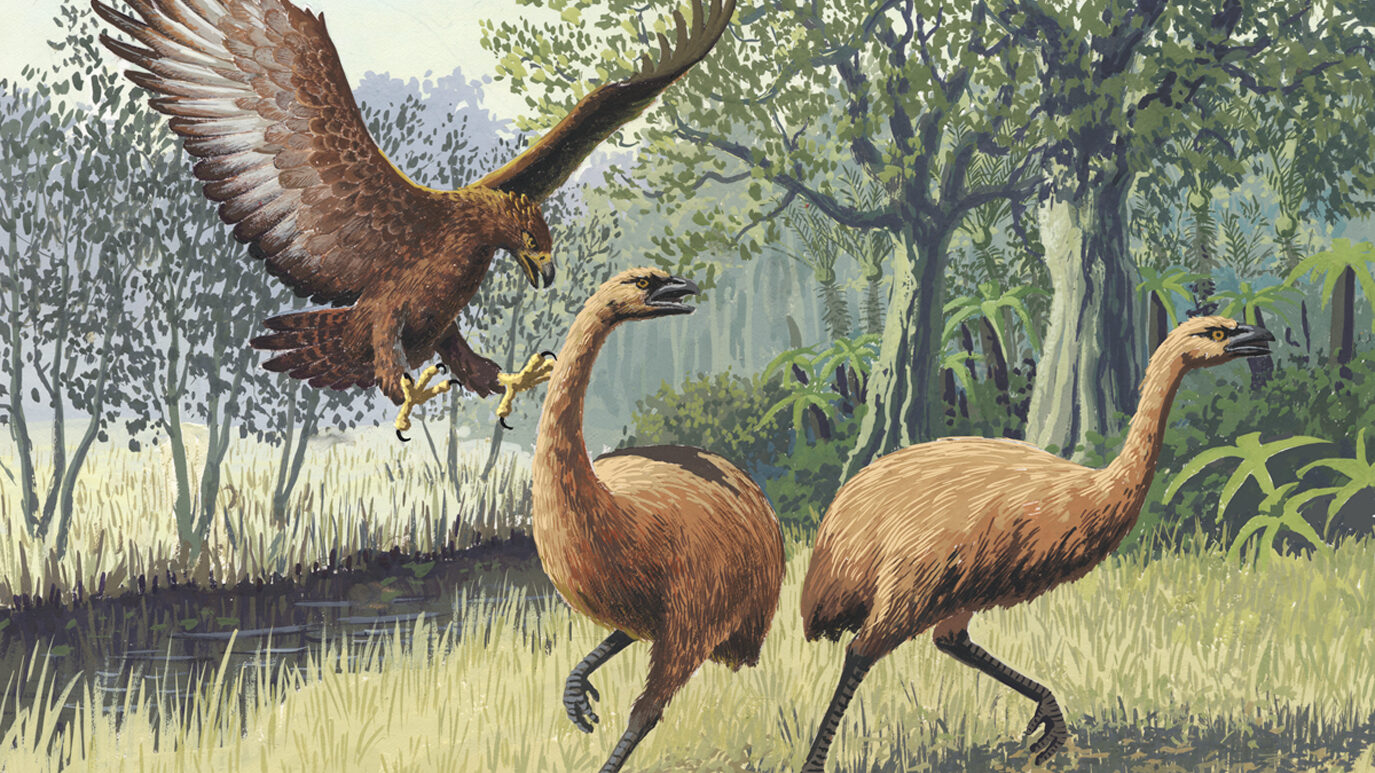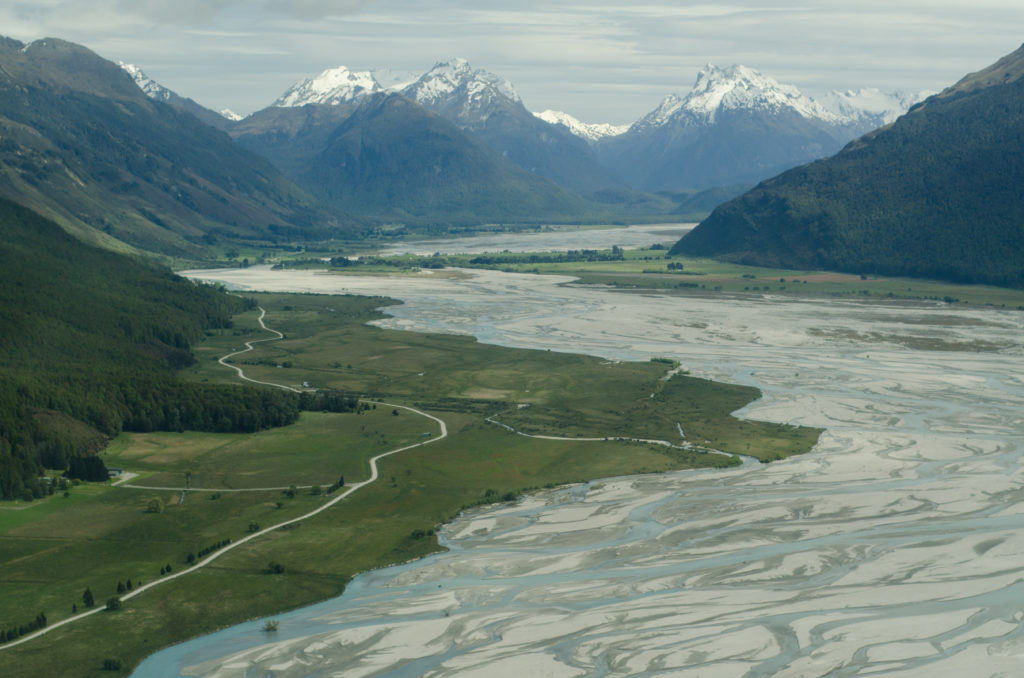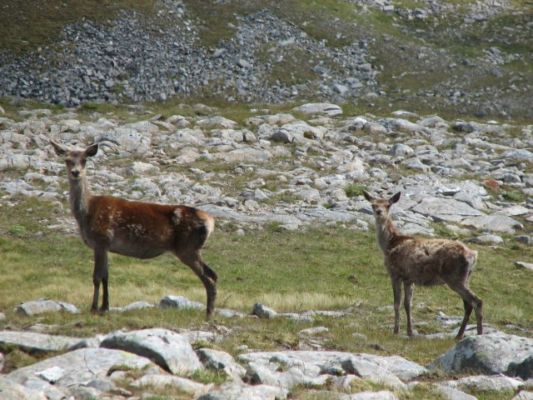Control possums, rodents and large introduced grazers and the forest understorey explodes with growth. It’s easy to think that this is what the original forests of Aotearoa must have looked like, before Man and other mammals arrived. But ancient Aotearoa had its own large herbivores – the various moa species, that grazed the forest understorey.

Moa ate many of the same foods that deer eat today. So have feathered herbivores simply been replaced by furry ones inhabiting the same ecological niches? If not – then what is different? Those are the questions examined in a paper by Jamie Wood and Janet Wilmshurst just published in the open access online journal PLOS ONE.
“In New Zealand it has been suggested that post-19th Century mammal introductions (e.g. deer and hare) may have filled ecological niches left vacant after the 15th Century AD extinction of large avian herbivores (moa). We quantified pollen assemblages from fecal samples deposited by these two asynchronous herbivore communities to see whether they were comparable.”
Moa weren’t just one species. They came in a variety of sizes and occupied various habitats and ecological niches.

“Nine species of the ratite moa were the largest (ranging from 20kg–250 kg) native herbivores in terrestrial ecosystems but were rapidly exterminated following initial human settlement some 750 years ago. For about 400 years after the extinction of moa, New Zealand had no large herbivores. However, large herbivore communities were once again restored following the introduction of browsing ungulates, particularly deer, during the 19th Century.”
Perhaps a ‘grazed’ forest is, historically, a more natural state than a forest of lush undergrowth.
“While clearly very different organisms, it has been suggested that in terms of their effect on vegetation communities deer may act as ecological surrogates for the extinct moa, and that vegetation communities browsed by deer may be more similar to their natural (i.e. pre-human) state than to the communities that existed during the intervening ‘herbivore-gap’ period. In addition, it has been suggested that smaller introduced mammals, such as sheep and rabbits may also offer some degree of surrogacy for certain seed dispersal roles and disturbance effects once provided by moa.”
Swap a few new species for the extinct ones – problem solved? Maintaining nature’s balance is unlikely to be that simple.
“The idea that mammals are true ecological replacements for moa continues to promote interest in popular media, despite researchers having noted a variety of ways in which the ecosystem effects of mammals likely differed from those of moa; the result of different feeding mechanics (i.e. chewing vs. plucking), population densities, and physical disturbance (e.g. ring-barking and soil distubance by ungulates). Moreover, recent evidence of moa diets derived from coprolite (preserved dung) analyses and palynological records (living and fossil pollen grains and plant spores) of forest composition change after the extinction of moa, also cast doubt on the similarity of mammals and moa in terms of their ecosystem impacts.”
So ecological impacts from grazing deer are probably different to moa grazers. But how can that be measured and determined scientifically? The researchers compared the pollen and plant spores in fossilised moa dung with dung from modern-day deer occupying the same area of native-dominated forest.
“The study site is a large rock avalanche deposit immediately north of Daley’s Flat in the Dart River Valley, West Otago. The deposit is dated to at least 1,000 years BP (before present) and a dry floor beneath an overhanging boulder near the center of the rock avalanche deposit has yielded a significant accumulation of coprolites from four sympatric moa species: South Island giant moa (Dinornis robustus), heavy-footed moa (Pachyornis elephantopus), upland moa (Megalapteryx didinus) and little bush moa (Anomalopteryx didiformis). The coprolites were deposited over a ~400 year period, ending with the local extinction of moa in the late 14th Century AD. DNA, plant macrofossil and pollen analyses of these coprolites have (previously) provided insights into niche partitioning between moa species. Here, we use the pollen data presented to compare against our new pollen data from mammal pellets collected at the same site.”
The forest on the Daley’s Flat rock avalanche deposit is classified as montane red-mountain-silver beech forest.
“In July 2010 we collected deer and hare pellets on and around the Daley’s Flat rock avalanche deposit within 900 meters of the rockshelter where the moa coprolites (fossil dung) had been collected.”
Analysing the pellets was a complex procedure.
“Mammal pellets were processed for pollen and spore analysis following the same methods used to process moa coprolites from the site. This included removal of the outer surface of pellets, followed by heating in potassium hydroxide for 10 min, treatment with hydrochloric acid, flotation separation of pollen grains using lithium polytungstate (specific gravity, 2.2), acetolysis, staining, and mounting on microscope slides. A minimum of 240 pollen grains were counted, except for five samples where low pollen density prevented this target from being reached.”
The researchers identified pollen from canopy and sub-canopy trees and shrubs, as well as spores from ferns.
“Overall there appeared to be little difference in the occurrence of canopy tree pollen types within moa coprolites and deer pellets. One minor difference was the slightly higher abundances of silver beech pollen in deer pellets.”
“While subcanopy tree pollen types often occurred in relatively high abundances (mean = 23.76% ± 4.16) in moa coprolites (at least in those species that fed in forest, i.e. Dinornis, Megalapteryx and Anomalopteryx) they were much rarer in deer and hare pellets, and no subcanopy tree pollen type ever exceeded 1% of the total pollen assemblage in any mammal pellets. For example, Coprosma pollen showed perhaps the most striking difference, as it was present in every moa coprolite (and representing up to 98.4% of the pollen assemblage per coprolite) but was not recorded in any of the mammal pellets.”

Differences in fern spores and other plant types were also observed.
“Fern spores occurred in almost all samples. Notable differences were the higher frequency of occurrence of Ophioglossum spores in moa coprolites (64.7% of coprolites) compared to hare (0%) and deer (10%) pellets. Monolete fern spores (which include common ground ferns such as Blechnum and Polystichum) generally occurred at higher abundances in deer pellets (mean = 20.03% ± 4.13) compared to moa coprolites (mean = 5.26% ± 0.98), and the overall mean abundance of fern spores was highest in deer pellets (mean = 25.34 ± 4.55).”
Muehlenbeckia also demonstrated major differences in relative abundance between moa coprolites and mammal pellets.
“Muehlenbeckia pollen differed markedly between moa coprolites and deer pellets both in terms of occurrence frequency (78.4% of coprolites vs. 5% of deer pellets) and mean abundance (11.1% in coprolites vs. 0.38% in deer pellets). A range of other ground cover or herbaceous pollen types were detected in moa coprolites but were absent from mammal pellets.”
Thus, the overall composition of pollen and spore assemblages of moa coprolites differed markedly from those of mammal pellets. This pollen data obtained from moa and deer dung reflects both the local habitat they were grazing (what plants grew there) and the food preferences of the herbivore that deposited the dung.
“The results reveal that the current forest understory is relatively sparse and species depauperate compared to the prehistoric state, indicating that deer and moa had quite different impacts on the local vegetation community.”
Observations made during the field work also supported the pollen data.
“During fieldwork on the Daley’s Flat rock avalanche deposit we observed that the forest understory was relatively sparse in small trees and shrubs, but that relatively dense and species-rich stands of these existed on top of very large boulders (>5m tall) that are inaccessible to deer. The low abundance of these pollen types in the deer pellets cannot be explained by differential diet preferences, as most of these taxa (Coprosma, Aristotelia, Myrsine, Hebe, Pseudopanax, Griselinia and Fuchsia) include preferred food species of deer, or species for which no avoidance has been detected. Therefore, it seems clear that higher population densities and/or greater browse intensity of deer compared to moa have driven the loss of these palatable subcanopy trees and shrubs, which had remained relatively common in the presence of moa.”
This study of moa coprolites and deer pellets from a forested environment is the first direct comparison of the droppings of these two large herbivore groups in New Zealand at the same location and in a vegetation community that has not experienced clearance or other significant alteration by human activities.
“Overall our results reflect significant differences in the structure and composition of the forest understory in the presence of deer, compared with the forest understory in which moa once roamed. They indicate that the current forest understory is relatively sparse and species depauperate compared with the prehistoric state, which is consistent with what is known about the impacts of deer browse on New Zealand forest understories.”
The full research article is freely available online through the PLOS ONE website.

